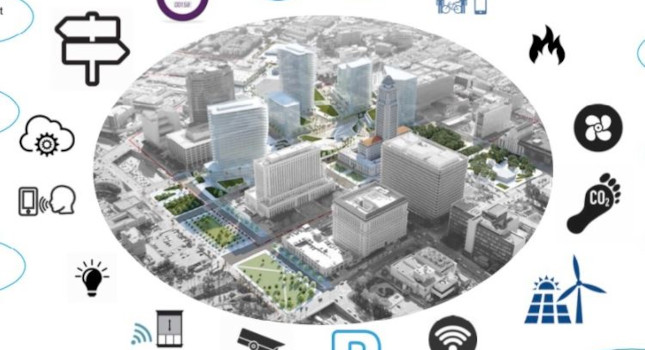Smart building technologies have gained more visibility due to COVID-19, but the long-term benefits they provide will last long after the pandemic subsides.

Smart building technologies gained popularity during the pandemic as office tenants turned their attention toward health and safety. These include mobile apps to ensure social distancing at office properties, sensors for monitoring space occupancy and indoor air quality (IAQ) and thermal imaging cameras to screen visitors’ temperature. These technologies offer benefits that extend far beyond the prevention of COVID transmission. They’ll continue to gain traction in the post-pandemic landscape. The four biggest reasons are highlighted.
1. Cost savings
Sensors, a fundamental component of smart buildings, promote savings in two ways — through automation and through occupancy analytics. Many people have probably encountered examples of automation in many kinds of buildings such as light sensors that automatically turn on when someone enters a room or touchless faucets and hand dryers that respond to motion. Some buildings even feature smart thermostats like those used in high-end residences. Such thermostats turn off and on to coincide with arrivals and departures of inhabitants, whose whereabouts are tracked through GPS.
Sensors coupled with computerized systems also offer fault detection and diagnostics, which alert staff to potential equipment malfunctions, enabling rapid fixes that prevent mechanical failure and avoid downtime. A stitch in time saves nine. So does an alert that an HVAC system needs attention before it goes out, leading to a tenant exodus for 24 hours (and unhappy tenants who are less likely to renew their leases).
Just how much can landlords save by adopting smart building technologies? The American Council for an Energy Efficient Economy (ACEE) reports they can reduce annual energy consumption by as much as 33% for lighting, 28% for plugged equipment and 18% for HVAC systems. Fault detection and diagnostics for HVAC can increase the savings by an additional 11%.
Occupancy analytics yield even greater savings in the longer term. The data reveals occupant behaviors, allowing landlords to adjust systems and increase efficiencies. Furthermore, analysis enables better budgeting and planning.
2. Environmental sustainability
The World Green Building Council reports operational emissions from buildings (from energy used for heating, cooling and lighting) account for 28% of all carbon emissions in the world. Many landlords concerned about climate change are already taking steps to reduce the carbon footprints of their buildings. Others will have no choice but to act because of governmental mandates such as New York City’s Local Law 97, California’s Title 24 and New York State’s 2050 Net Zero challenge. Smart building technologies will help real-time energy efficiency monitoring. They’ll help show landlords where and what they need to upgrade to meet the legislated standards.
3. Improved occupant experience
COVID-19 increased attention on IAQ. However, occupants of office buildings want good indoor air quality all the time; not just during pandemics. Thanks to smart building technologies, occupants can find out — often via an app or dashboard — whether the several common volatile organic compounds (VOCs) and substances exceed threshold limit values. Examples include PM2.5/10, carbon monoxide (CO), carbon dioxide (CO2), radon, polycyclic aromatic hydrocarbons (PAHs), formaldehyde, methylene chloride, nitrogen dioxide (NO2), etc. As landlords and employers strive to persuade tenants and employees to return to the office, they can emphasize this data. WELL certification further supports such efforts.
Employees also appreciate touchless and personalized experiences on-site. It’s convenient for them to present their ID card/mobile credential apps at a lobby turnstile, prompting an elevator call and, subsequently, a quick trip to the correct floor, no buttons required. If employees are hot-desking, they can use apps on their cellphones to see where the free desks are and reserve the one they want. Wayfinding apps can help them get there quickly. Once they arrive, they can control the lighting and temperature around the desk to ensure personal comfort.
All of these features contribute to a workplace environment that is appealing and, in many cases, more comfortable and inspiring than a home office. They also support the agility and flexibility critical to the success of a hybrid work model (combining remote and on-site), which many experts believe will be the “new normal.”
4. Enhanced security
It’s unpleasant to consider, but the safest buildings are equipped to minimize casualties from mass shootings, which are far too common across the U.S. Smart building technologies can once again play an important role. Sensors recognize the sound of a gunshot. Security systems respond by locking all the doors in the area where the shooter is, restricting his or her free movement and blocking escape. Cameras capture the scene and pinpoint the exact location for local authorities, who are immediately alerted.
New expectations post COVID-19
The pandemic will eventually abate and so will concerns about virus transmission. However, tenants and employees will still seek safe, healthy and personalized environments that enhance the workplace experience. Landlords will still aim for cost savings, energy efficiency and tenant retention. That’s why smart building technologies are going to stick around post-COVID. Owners who want to optimize their portfolios and attain a high return on investment know what they have to do — get smarter.
Val Loh is senior principal at Syska Hennessy Group Inc., a CFE Media content partner.




